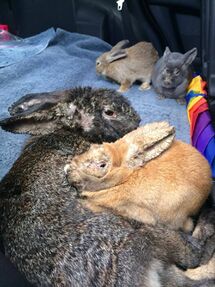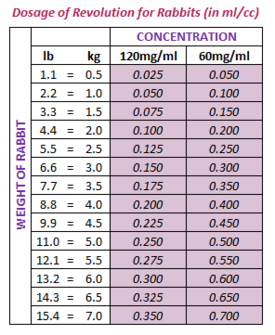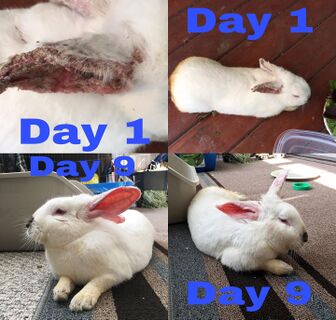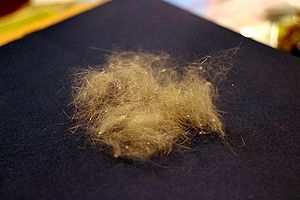Mites
This article is incomplete because it lacks depth or is unfinished. Help by expanding it.
Mites that can infest rabbits range from fur mites and ear mites to burrowing mites that cause mange.
Burrowing mites
The burrowing mite species Sarcoptes scabiei and Notoedres cati have been associated with mange in rabbits. Mange caused by Sarcoptes scabiei is referred to as sarcoptic mange. Sarcoptic mange is rare in the UK, although it is common in other parts of the world such as Africa.[1]:298
Symptoms

- Itchy lesions found especially on the face, nose, lips, and external genitalia, but can also be found on the outer ears and back of the neck.[1]:298
- Skin is covered in yellow scaly crust.
Treatment
Medications effective against mange include the following:[1]:298[2][3]
- Ivermectin: subcutaneously every 10-14 days for 3 treatments
- Selamectin (Revolution): topically every 30 days for 2 treatments
- Moxidectin: subcutaneously every 10-14 days for 3 treatments.
Experiences
- u/kinenchen. (2014). Dumped rabbits infested with mange (Graphic)
Extra resources
- MediRabbit.com, Mange: burrowing mites; Sarcoptes scabiei or Notoedres cati. (Graphic)
Ear mites
Ear mite infestations in rabbits are caused by the parasite Psoroptes cuniculi. They can affect only one ear or both, and symptoms may spread to the rest of the body such as the perineal skin folds.[1]
These mites are large and active and are visible to the naked eye. They are surface nonburrowing dwellers that cause intense irritation when present in large numbers.[1]:442 The spend their entire 3-week life cycle on the host, and eggs hatch within three days.[4]
Causes
Rabbits can get ear mites through a few methods:
- Exposure to affected rabbits in areas like pet stores, shelters, and multiple rabbit households
- Exposure to fomites like hay, grass, straw, or bedding
Ear mites can be found in any age rabbit and any gender.
Symptoms

- Crusting and ulceration of the external ear canal, head, or neck.
Diagnosis
Ear mites can be diagnosed through the following:
- Ear swabs placed in mineral oil and examined under low magnification.
- Skin scrapings to identify mites.
- Otoscopic examination.
Ear mites are also visible to the naked eye.
Treatment
Ear mites are extremely contagious, and all rabbits in contact should be treated.
It is extremely important to clean and treat the environment. Mites can live on exfoliated crusts for up to 21 days depending on conditions.[4] All organic materials such as wood or paper bedding should be regularly discarded every day during the treatment period. All combs, brushes, and grooming utensils should be either discarded or thoroughly disinfected before reuse.
Medications effective against Psoroptes spp mites include the following:[3]
- Doramectin (Dectomax): subcutaneously or orally in a single dose.
- Eprinomectin: subcutaneously once or repeated every 2-3 weeks as necessary.
- Fluralaner (Bravecto): orally once.[5][6]
- Imidacloprid + moxidectin (Advantage Multi): topically every 4 weeks for 3 treatments
- Ivermectin: subcutaneously every 10-14 weeks for 3 treatments
- Moxidectin: orally every 10 days for 2 treatments
- Selamectin (Revolution): topically once.
Topical ear antibiotic or antifungal medications are usually not required as secondary ear infections are usually the result of overzealous cleaning of the ears.[4]
Extra resources
- MediRabbit. Ear mite: Psoroptes cuniculi
- PetMD. Infestation of Mites in the Ear in Rabbits
- Clinician’s Brief. Online Gallery: A Close-Up on Ear Mites
Fur mites
Fur mites that infest a rabbit are most commonly Cheyletiella spp. and less commonly Leporacarus gibbus (formerly known as Listrophorus gibbus).
The highly contagious Cheyletiella spp. mites are zoonotic and can also live on cats and dogs. These mites can temporarily infest humans when they pet or hold an infested rabbit and cause skin irritation and itching.[7] They are a non-burrowing mite and live on the surface skin layer. Fur mites are often referred to as "walking dandruff" due to the large mite size that cause them to be visible to the naked eye. and excessive flaking of the skin.
The life cycle of Cheyletiella spp. mites is approximately 35 days of which the entirety are spent on the host. Most rabbits do not show symptoms of a fur mite infestation; the disease occurs in young animals, debilitated animals, or those with underlying diseases that prohibit adequate grooming.[4] In a survey of 220 laboratory rabbits, 43.2% had inapparent C. parasitovorax infestations.[1]
Infestations of the rabbit fur mite L. gibbus are usually asymptomatic, although hypersensitivity reactions have been reported.[1]:442 These mites inhabit the fur, can be seen with the naked eye especially on light-colored rabbits, and tend to move away from direct light. An infestation usually gives the coat the appearance of being sprinkled with pepper, especially when wet.[1]:442
Symptoms
- Loss or thinning of hair along the shoulders and middle back of the rabbit.
- Dandruff-like flakiness.
- Itching.
If you have sensitive skin, you may also experience some skin irritation when in contact with a rabbit with fur mites. Lesions are usually found on the forearms and neck.[1]
Causes
Fur mites can be found in any age of rabbit but is most common in young animals, debilitated animals, or those with underlying diseases that prohibit adequate grooming.[4] They may also be more common in long-haired rabbits.[4] Infestation with fur mites is often associated with obesity, spinal disorders, or dental disease.[1]:442
The inability to groom the rear end or tail base region can contribute to the start of irritation in these areas. A common source of fur mites are pet stores, shelters, and breeders.
Diagnosis
The veterinarian can obtain skin scrapings and sometimes see the mites under a microscope, but not always.
Diseases that can show similar symptoms include ear mite (Psoroptes cuniculi) infestation, mange (rare), flea hypersensitivity dermatitis, ringworm, and bacterial dermatitis.
In some rabbits, the lack of grooming alone can cause an accumulation of flakes without the presences of mites.
Treatment

There are several drug treatments available for rabbits with fur mites.[3]
- Selamectin (Revoluation, Stronghold): topically every 2-4 weeks for 2-3 treatments.[8]
- Ivermectin (topical, oral, subcutaneous) once every 10-14 days for 2-4 treatments.[4][9][10]
- Doramectin: orally in a single dose.
- Moxidectin: subcutaneously every 10-14 days for 3 treatments.
- Carbaryl powder (5%) can be applied topically once weekly and can also be used to treat the environment.[4]
Do not use fipronil [Frontline® - Merial]. Fipronil is effective in eliminating Cheyletiella sp., however, serious adverse effects such as depression, anorexia, seizures, and death have been observed in rabbits, especially young and small ones.[11]
Imidacloprid (Advantage®) is also not effective against fur mites.[11]
Additional treatment includes the following:[4]
- All animals in the household should be treated including cats and dogs.
- Rabbits should be combed daily to remove skin flakes.
- Bathing and lime-sulfur rinses can be effective in removing skin flakes but is dangerous to perform on rabbits due to their thick dense fur, restraint, and risk of both overheating and chilling.
- The environment should also be treated and regularly cleaned to eliminate the infestation as eggs and adult female mites can live up to 10 days off of a host.[1] Larvae, nymphs, and adult males are less resitant and die in about 2 days in the environment.[1] Remove and discard all organic material such as wood and paper products, and replace litter daily during the treatment period.
- Combs, brushes, and grooming utensils should be replaced or thoroughly disinfected before re-use.
Treatment failure necessitates reevaluation for other causes of symptoms. Reinfestation may indicate contact with an asymptomatic carrier or the presence of an unidentified source of mites (e.g. untreated bedding).[4]
Extra resources
- MediRabbit, Esther van Praag Ph.D., Common Fur Mites or Cheyletiellosis
- Rabbits For Pets, Rabbit Mites – Symptoms & Treatment
- Angie Pollock, Treatment for fur mites in rabbits
- Drs. Foster & Smith, Cheyletiella parasitovorax (Rabbit Fur Mite)
- BunSpace, Fur Mites- Treating the Bun and Its Living Environment
- Bayer (South Africa), Advantage datasheet, local - Do not use dosing in file.
Harvest mites
Harvest mites Neotrombicula autumnalis can infest rabbits that have access to outdoor habitats where harvest mites are found. Adult mites lay their eggs in the soil, and the larvae on hatching move onto low vegetation to await a host. Larvae can survive up to 30 days without a host.[1]
In rabbits, the larvae are most commonly found on the ears, anus, the corners of the eyes, and feet. Their feeding process causes severe skin flaking and the formation of bumps and discoloration on the skin. Treatment is difficult, but the disease is seasonal and self-limiting. Removing the rabbit from the infested area prevents further reoccurrences.[1]
Demodex cuniculi
Although not common, Demodex cuniculi has been found in skin scrapings from rabbits in the UK.[1] The mite can live on the skin of normal rabbits in the abscence of associated clinical signs.
Ornithonyssus bacoti
Infestions by Ornithonyssus bacoti mites are common in small rodents and laboratory rabbit colonies but uncommon in pet rabbits.[3] Heavy infestations can lead to severe anemia, and can be identified with skin scrapings.
Psorobia lagomorphae
A new subspecies of Psorergatid mites recently identified causes mild flaking in rabbits.[1] There are no published reports regarding treatment.
Further reading
- Esther Van Praag, Ph.D., Common Mites (Arachnids) of Rabbits and Their Treatment
- Dana Krempels, Ph.D., Fur Loss and Skin Problems in Rabbits: Common Causes and Treatments (search Mites)
- Deborah L. Cole, Jeannette Rea-Keywood, and Mary Ann Metz, Common Mites of Your Rabbit and Small Animal
- Rabbitmatters.com, The correct care plan for rabbit mites
- AEMVvets (Instagram), Managing the Pruritic Rabbit
See also
References
- ↑ 1.00 1.01 1.02 1.03 1.04 1.05 1.06 1.07 1.08 1.09 1.10 1.11 1.12 1.13 1.14 1.15 Varga, M. (2013). Textbook of rabbit medicine. (2nd ed.).
- ↑ Animal Hospital of Soquel. (2015). External Parasites in Rabbits. Retrieved 31 Dec 2020 from https://soquelvet.com/blog/94518-external-parasites-in-rabbits
- ↑ 3.0 3.1 3.2 3.3 David Eshar, DVM, DABVP (ECM), DECZM (SM & ZHM). (2019). Ectoparasites in Rabbits. Retrieved 19 Apr 2022 from https://cdn.brief.vet/web-files/DE/CB+Canadian+April+2019+Digital+Edition.pdf
- ↑ 4.0 4.1 4.2 4.3 4.4 4.5 4.6 4.7 4.8 4.9 Oglesbee, B. (2011). Blackwell's five-minute veterinary consult: Small mammal. (2nd ed.).
- ↑ Sheinberg, G., et al. (2017). Use of oral fluralaner for the treatment of Psoroptes cuniculi in 15 naturally infested rabbits. Retrieved 01 Oct 2019 from https://www.ncbi.nlm.nih.gov/pubmed/28251698
- ↑ HouseRabbit Adoption Rescue and Education. (2019). Facebook post. Retrieved 01 Oct 2019 from https://www.facebook.com/permalink.php?story_fbid=2652393374800084&id=155502407822539
- ↑ Centers for Disease Control and Prevention, Small Mammals > Diseases. Accessed Jan 6, 2016.
- ↑ Dana Krempels, Ph.D., Fur Loss and Skin Problems in Rabbits: Common Causes and Treatments > Cheyletiella parasitivorax (fur mites) or Leporacus gibbus
- ↑ Smith, K. (2003). Rabbit Health in the 21st Century. (2nd ed.).
- ↑ Raising-Rabbits.com, Fur Mites in Rabbits
- ↑ 11.0 11.1 Esther van Praag Ph.D., Common Fur Mites or Cheyletiellosis



